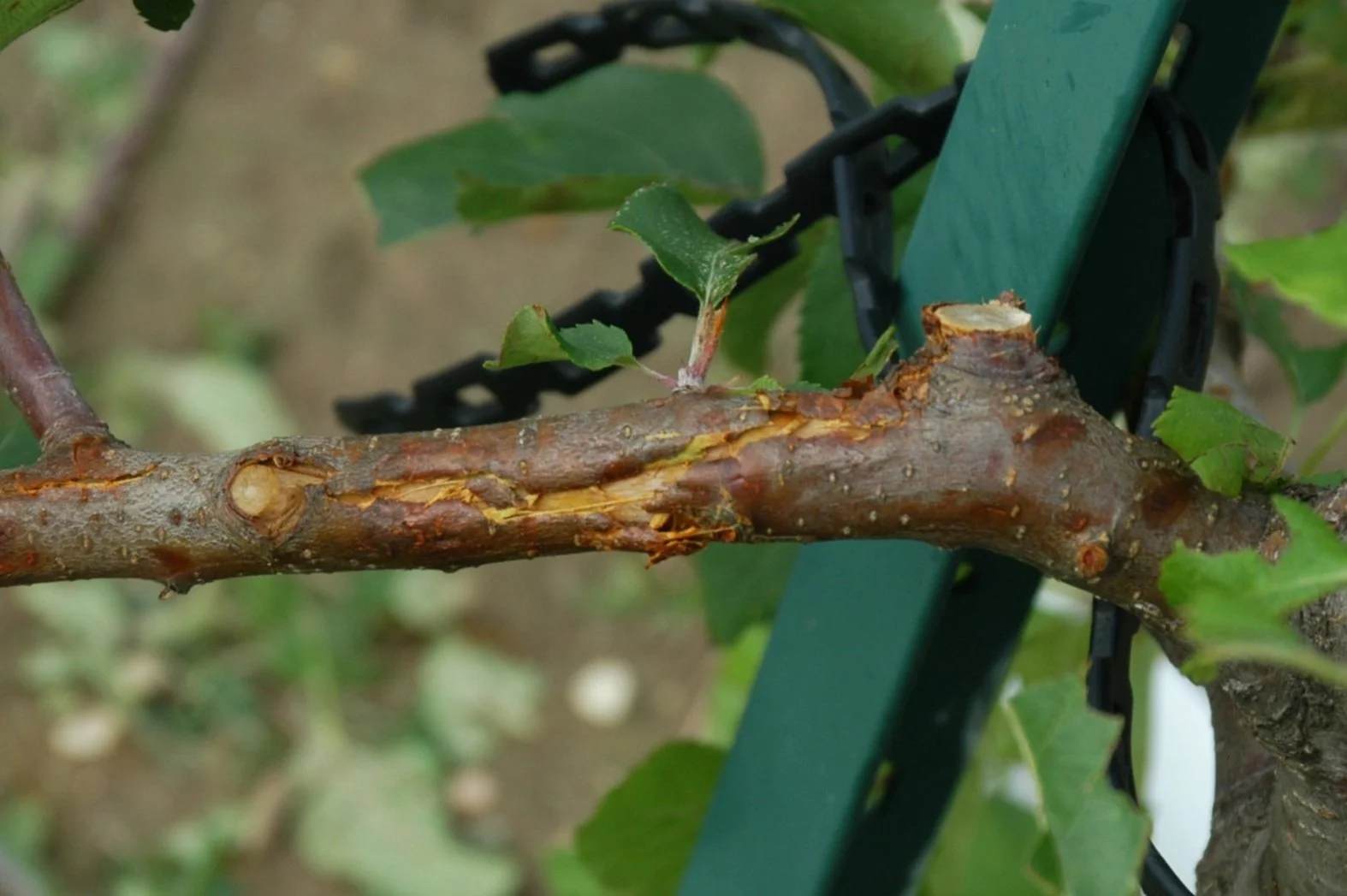Managing Hail Damage In Trees
Hail wound on Red Pine.
Unfortunately, we’ve had a very active spring and early summer storm season bringing both wind and hail damage to many landscapes. Of course, hail damages plants directly, with the level of damage ranging from minor to severe, but it also makes them more susceptible to disease infection and reduces their ability to tolerate summer heat and dry conditions. It’s important to recognize the visible and hidden damage caused by hail when determining the best methods for managing plants to aid their recovery.
MINOR DAMAGE
Hail wound on Apple Tree.
With minor damage, such as slight defoliation, nothing needs to be done except provide good basic care for the remainder of the growing season including deep infrequent irrigation when summer conditions turn dry. Apply water deeply, moistening the soil to a depth of about 12-18 inches. Focus on the entire area underneath the tree’s dripline if possible and don’t water again until the soil begins to dry out. Recommend clientele NOT water established trees multiple times per week - this is a good way to kill their trees.
Make sure trees are mulched, with 3-4 inches of an organic material like coarse wood chips, to help conserve soil moisture. Make sure it’s a flat pancake-like layer of mulch, not piled up like a volcano against the tree’s bark. Keep it far enough away that it doesn’t touch the tree’s trunk.
Do not automatically fertilize trees and shrubs to “help them recover.” Fertilizer is usually not be needed and can be detrimental by forcing the tree to produce fast-growing lush foliage, at the expense of other recovery efforts such as root growth or wound closure. If the tree is growing in a lawn which is fertilized during the summer, then it’s getting plenty of fertilizer already. High nitrogen levels makes trees more attractive to insect pests.
MAJOR DAMAGE
Major damage includes 1) stripping of 50% or more of plant foliage, 2) pocks or tears in tree bark with damage to the underlying xylem and phloem tissues, 3) shearing of evergreen buds from branch terminals, 4) death of evergreen buds due to impact damage, and 5) broken tree or shrub branches.
Although it’s not readily visible, damage to a tree’s vascular system from hail can be very serious as it limits the tree’s ability to move water up from the roots and into the secondary branches and leaves. Movement of nutrients throughout the tree is also reduced. Over the next few years, previously healthy vigorous trees will produce callus tissue to seal off bark wounds and re-establish vascular function. Until then, they have a reduced ability to move water and cope with dry conditions, which in Nebraska are often exacerbated by high winds that accelerate water loss from leaves.
Hail wound on Aspen Vascular Tissue.
In most cases, homeowners should be advised to take a “wait and see” attitude. Trees and shrubs should be kept well-watered throughout summer and fall to avoid drought stress. Keep plants mulched to prevent secondary injury from mowers and string trimmers.
Evergreens. Secondary pests, such as borers and aphids, should be controlled to avoid additional stresses. Sphaeropsis tip blight can be a serious problem in pine trees during the year following serious hail injury. Fungicide applications should be made to protect wounded trees and planned for next spring to keep infection to a minimum.
For more information on fungicides and spray schedules for evergreen disease problems: Diseases of Evergreen Trees, Nebraska Forest Service. http://nfs.unl.edu/documents/foresthealth/diseasesevergreen.pdf
Fruit trees. Copper fungicide applied to damaged fruit trees will help protect wounds from infections by common pathogens like brown rot, bacterial canker, bacterial spot, and fire blight. However, these applications must be made immediately after the storm; wounded tissues have died and dried out by 24-48 hours after the storm and are no longer susceptible to infection. Fungicides applied at this point are not helpful.
Never apply a wound dressing or pruning paint to any wounds, including hail wounds as these products can interfere with the tree’s own response to closing the wound. Do not wrap the tree trunk or branches; this creates a hidden area where insects can cause damage without being seen.
Perennials. For hosta, rhubarb and other perennials which suffered severe hail damage, it’s best to remove any broken stems but allow leaves with intact stems to stay even if they are torn and tattered. When new growth begins to appear, the tattered leaves can gradually be removed.
Removing all of a plant’s foliage at once by cutting it back to the ground will ultimately reduce plant vigor. The plant will be forced to use stored energy reserves to regrow new leaves without the benefit of any photosynthetic foliage to aid the regrowth.
Sarah Browning is an Extension Educator with Nebraska Extension and can be contacted by phone 402 441-7180, by mail at 444 Cherrycreek Road, Ste A, Lincoln, NE 68528: or by e-mail sarah.browning@unl.edu. Learn more about Nebraska Extension at Extension.unl.edu.
Photos in folder – please add byline under each photo
1. Hail wound on red pine. Such wounds may serve as infection courts for Sphaeropsis. Image by Joseph OBrien, USDA Forest Service, Bugwood.org.
2. Hail wounds on an apple tree branch may kill the branch directly or open it up for infection by canker diseases. Image by Sarah Browning, Nebraska Extension.
3. Cankers on aspen, initiated through hail wounds. Image by Sarah Browning, Nebraska Extension.
4. Aspen vascular tissue killed by impact from hail stones. Image by Steven Katovich, Bugwood.org



